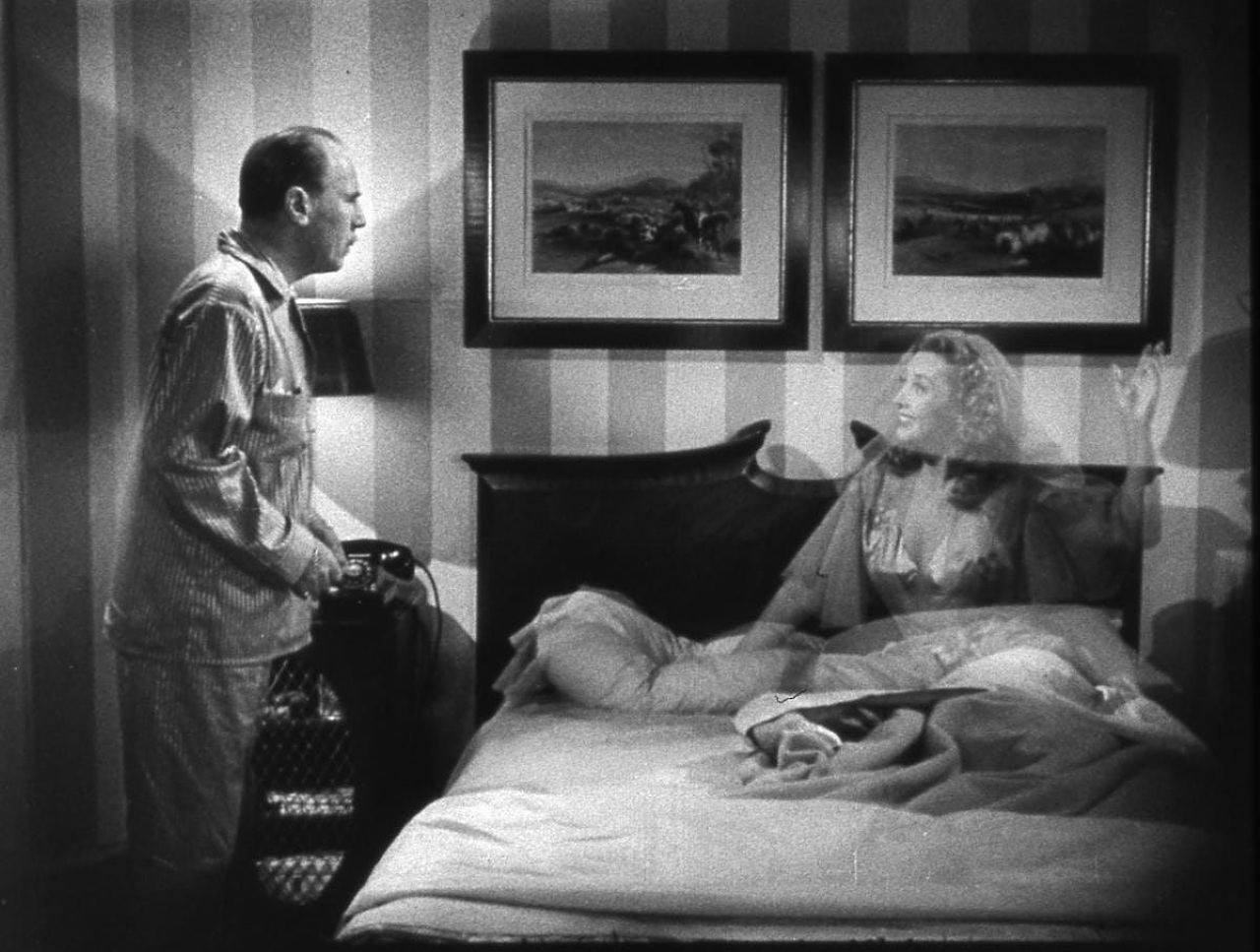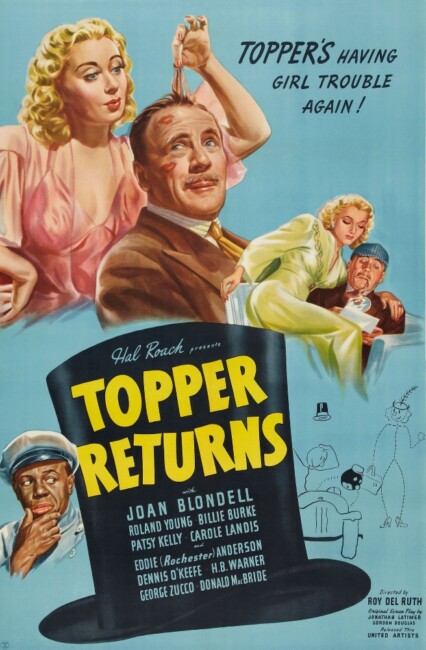Crew
Director – Roy Del Ruth, Screenplay – Gordon Douglas & Jonathan Latimer, Additional Dialogue – Paul Gerard Smith, Photography (b&w) – Norbert Brodine, Music – Werner R. Heymann, Photographic Effects – Roy Seawright, Art Direction – Nicolai Remisoff. Production Company – Hal Roach Studios, Inc.
Cast
Roland Young (Cosmo Topper), Joan Blondell (Gail Richards), Carole Landis (Ann Carrington), Billie Burke (Clara Topper), Eddie ‘Rochester’ Anderson (Eddie), Donald MacBride (Sergeant Roberts), Dennis O’Keefe (Bob), H.B. Warner (Mr Carrington), George Zucco (Dr Jeris), Rafaela Ottiano (Lillian), Patsy Kelly (Emily), Trevor Bardette (Rama)
Plot
Ann Carrington is travelling home to meet her father for the first time in many years when the taxi she is in breaks down. She and her friend Gail Richards are forced to catch a ride with Cosmo Topper who lives next door to the Carrington house. Topper’s wife Clara becomes upset when she sees him driving by with Gail on his lap. As they settle into the house, the girls decide to swap rooms. That night, a masked figure sneaks into Gail’s room and stabs her, thinking she is Ann. Her spirit then gets up off the bed and wanders across to Topper’s house to beg his help. Aided by Gail’s ghost, Topper breaks into Carrington House to solve the murder. There he is plunged into a series of mishaps involving the mystery killer, Gail’s ghost, trying to protect the real target Ann and avoiding being arrested as the murderer himself, not to mention the ire of his wife.
Topper Returns was the third in the series of popular light fantasies that began with the hit screwball comedy Topper (1937). The basic premise of Topper concerned dull ordinary bank manager Roland Young being haunted by the couple who were killed while driving the car he subsequently buys. (The male half of the couple was played by a then unknown Cary Grant). The film’s comedy played out (with an enormous deal of energy) on the premise of the two ghosts becoming invisible companions who made Topper’s life a misery.
The first sequel was Topper Takes a Trip (1939) minus Cary Grant wherein comic complications ensue when Topper’s wife sues for divorce because of his strange behaviour. This was a third and final entry, where the only returnees this time are Roland Young and Billie Burke as his wife. Ahead would be the tv series Topper (1953-5) starring Anne Jeffreys and Robert Sterling as the ethereal couple and with Leo G. Carroll as Topper and an unsold tv pilot Topper (1979) starring Kate Jackson and Andrew Stevens as the ghostly husband and wife and Jack Warden as Topper.
With Topper Returns, the series draws clear and undeniable inspiration from the hit remake of The Cat and the Canary (1939) starring Bob Hope two years earlier. The Cat and the Canary‘s success lay in taking the Old Dark House genre of the previous decade – creepy old thrills set around a big old mansion and usually a plot to kill/drive a young pretty heiress mad – and playing them for comedy. Topper Returns throws in a bunch of the tropes and cliches from the Old Dark House genre – the big gloomy old mansion, the heiress and improbable schemes to kill her, figures skulking in the shadows, various murders, sliding/rotating hidden panels, disappearing bodies.

Director Roy Del Ruth whips it up into a lively froth. Everything arrives at a typical whodunnit solution (even if it is not clear at the denouement why the particular individual was impersonating Joan Blondell’s father and trying to kill her). The noteworthy thing about the Old Dark House genre, whether played seriously or comedically, is that the appearance of the ghostly and supernatural was always revealed to be of mundane origin at the end – thus Topper Returns has the distinction of being probably the only film of the Old Dark House genre to feature actual ghosts.
The ghost scenes are played for droll comedy. These allow the special effects team to roll out all the effects shots that they perfected on the Universal Invisible Man films – Eddie ‘Rochester’ Anderson lighting a cigarette for a phantom Joan Blondell and she blowing smoke back at him, she putting on a slip, the ghost invisibly rowing a dinghy, even a comic scene with the ghost driving a car with Eddie ‘Rochester’ Anderson in the back. The funniest and cleverest scene is the one where most of the group are locked up in a walk-in freezer and the dialogue between them makes a series of lightning-fast plays of puns and word associations.
The film is considerably lifted up by its performances. Roland Young plays with the same droll comic dullness he perfected throughout the other two films. Joan Blondell gives a wonderfully airy and funny performance through a chipper New York accent. She has a great bubbly comic presence that is perfect for playing off Young. While the plot is routine Old Dark House antics, it is Roland Young’s roly-poly absent-mindedness and the gaily blithe Joan Blondell that lift it up enormously. On the minus side, Eddie ‘Rochester’ Anderson is cast in one of the era’s racist cliches of the scared comic Black servant, at which he at least plays in a very lively way. One of the big plusses of Topper Returns is some amazingly good art direction – the scenes entering the various halls, libraries and bedrooms have a lushness that is almost edible at times.
Roy Del Ruth (1893-1961) was a director who had been working way back to the 1920s. He made the original The Maltese Falcon (1931) and various musicals, including several of the Broadway Melodies series. During the 1950s, he made two other films of genre interest with the Edgar Allan Poe adaptation Phantom of the Rue Morgue (1954) and the mad scientist film The Alligator People (1959).
Full film available here:-


